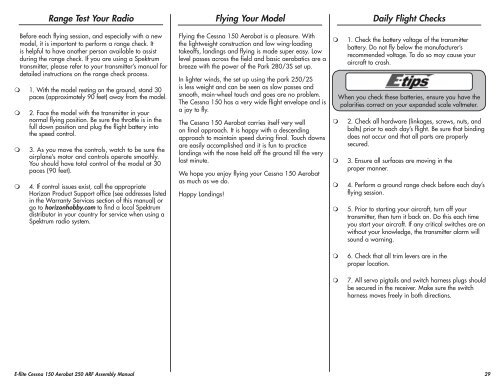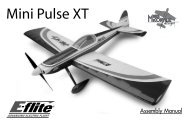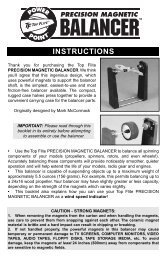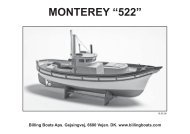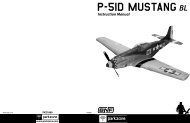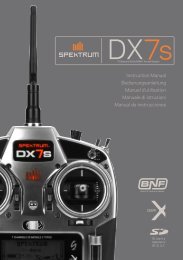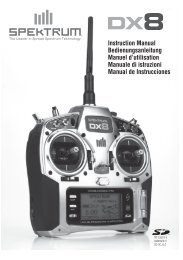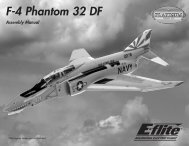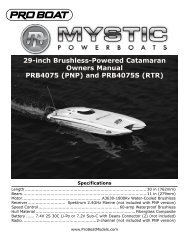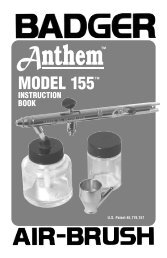Cessna 150 Aerobat 250 ARF - Great Hobbies
Cessna 150 Aerobat 250 ARF - Great Hobbies
Cessna 150 Aerobat 250 ARF - Great Hobbies
- No tags were found...
You also want an ePaper? Increase the reach of your titles
YUMPU automatically turns print PDFs into web optimized ePapers that Google loves.
Range Test Your RadioBefore each flying session, and especially with a newmodel, it is important to perform a range check. Itis helpful to have another person available to assistduring the range check. If you are using a Spektrumtransmitter, please refer to your transmitter’s manual fordetailed instructions on the range check process. 1. With the model resting on the ground, stand 30paces (approximately 90 feet) away from the model.2. Face the model with the transmitter in yournormal flying position. Be sure the throttle is in thefull down position and plug the flight battery intothe speed control.3. As you move the controls, watch to be sure theairplane’s motor and controls operate smoothly.You should have total control of the model at 30paces (90 feet).4. If control issues exist, call the appropriateHorizon Product Support office (see addresses listedin the Warranty Services section of this manual) orgo to horizonhobby.com to find a local Spektrumdistributor in your country for service when using aSpektrum radio system.Flying Your ModelFlying the <strong>Cessna</strong> <strong>150</strong> <strong>Aerobat</strong> is a pleasure. Withthe lightweight construction and low wing-loadingtakeoffs, landings and flying is made super easy. Lowlevel passes across the field and basic aerobatics are abreeze with the power of the Park 280/3S set up.In lighter winds, the set up using the park <strong>250</strong>/2Sis less weight and can be seen as slow passes andsmooth, main-wheel touch and goes are no problem.The <strong>Cessna</strong> <strong>150</strong> has a very wide flight envelope and isa joy to fly.The <strong>Cessna</strong> <strong>150</strong> <strong>Aerobat</strong> carries itself very wellon final approach. It is happy with a descendingapproach to maintain speed during final. Touch downsare easily accomplished and it is fun to practicelandings with the nose held off the ground till the verylast minute.We hope you enjoy flying your <strong>Cessna</strong> <strong>150</strong> <strong>Aerobat</strong>as much as we do.Happy Landings!Daily Flight Checks1. Check the battery voltage of the transmitterbattery. Do not fly below the manufacturer’srecommended voltage. To do so may cause youraircraft to crash.When you check these batteries, ensure you have thepolarities correct on your expanded scale voltmeter.2. Check all hardware (linkages, screws, nuts, andbolts) prior to each day’s flight. Be sure that bindingdoes not occur and that all parts are properlysecured.3. Ensure all surfaces are moving in theproper manner.4. Perform a ground range check before each day’sflying session.5. Prior to starting your aircraft, turn off yourtransmitter, then turn it back on. Do this each timeyou start your aircraft. If any critical switches are onwithout your knowledge, the transmitter alarm willsound a warning.6. Check that all trim levers are in theproper location.7. All servo pigtails and switch harness plugs shouldbe secured in the receiver. Make sure the switchharness moves freely in both directions.E-flite <strong>Cessna</strong> <strong>150</strong> <strong>Aerobat</strong> <strong>250</strong> <strong>ARF</strong> Assembly Manual29


